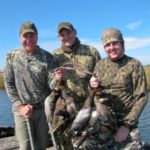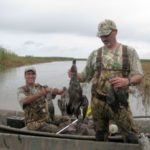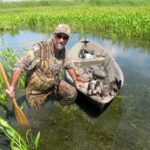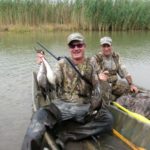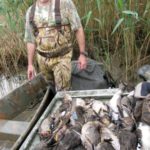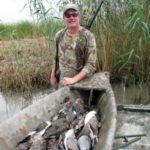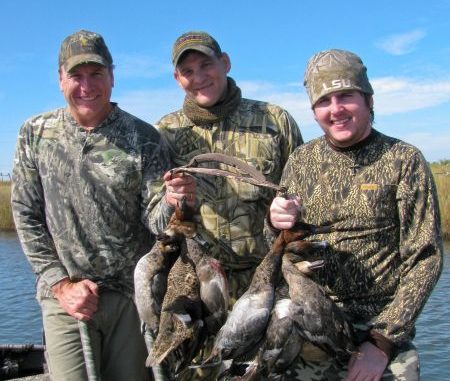
Sure, duck hunting hasn’t been easy the past several seasons. But you can still find epic hunts at the mouth of Old Muddy — if you throw out everything you know about duck hunting.
Dale Carnegie has nothing on LDWF waterfowl study leader Larry Reynolds. Nor does Henry Kissinger.
Friendly diplomacy seems Reynold’s trademark manner of communicating.
Remember the famous Cheech and Chong skit — Sister Mary Elephant? Where the kindly nun tries to bring a classroom of loud unruly brats into order?
“Good morning class.”
(Racket)
“Good morning class”
(Racket continues)
“SHUDD-UUUUUUP!” she finally thunders, achieving the desired effect.
But somehow Larry Reynolds maintains the “good-morning class” mode through all the racket of disgruntled Louisiana duck-hunters.
To wit:
It’s obvious to every person who duck hunts consistently in coastal (especially Southeast) Louisiana that our hunting has worsened.
This is backed up by more than just anecdotal evidence. Two years before hurricane Isaac battered our duck habitat, for instance, Delta National Wildlife Refuge biologist Jack Bohannon confided to your loyal servant that aerial surveys were showing barely one-third the ducks wintering in the refuge compared to just 10 years earlier.
Shane Granier, biologist in charge of Pass-a-Loutre Wildlife Management Area, said much the same — not from aerial surveys, but simply from his observations along with those of his colleagues in the delta.
And the habitat during these surveys and observations has been generally ideal.
Then came the 2011-12 season, when many of us rejoiced that maybe we were getting our coastal duck-hunting groove back.
Hah! Think again.
We can’t expect a horrendous drought in the Midwest every year. With the cropfields parched rather than flooded, the ducks had no choice but to continue all the way down the flyway to our mud, milfoil, widgeon grass and duck potato as in decades past.
The point is that the “hatch,” wasn’t the big issue for Louisiana hunters. How much of that hatch got down here was the issue.
In fact last year’s federal mid-winter survey posted by Larry Reynolds recently on Louisiana Sportsman hints at the issue of our declining percentage of the continent’s wintering ducks:
Lousiana Flyway Percent
1996-2000 3,820,000 6,392,000 60%
2001-2005 3,910,000 6,381,000 61%
2006-2010 3,109,000 6,531,000 48%
2011-2014 3,651,000 7,615,000 48%
“But wait a minute!” some still say. “You’re trying to tell us there are only a miniscule 4.4 percent fewer ducks in Louisiana the last few seasons than in the late ’90’s (about 160,000 fewer)?
“Jeeeez: That’s only about the size of one flock you’d find in, say, Pass-a-Loutre’s Sawdust Bend or Wax Lake’s Horeshoe Island in 1998 or Delacroix’s Shrimp Lagoon — or the number of dos gris between mile markers 8 and 10 along the Lake Pontchartrain causeway in 1998.”
“Gimme a break!” as the saying goes.
Many of us ain’t buying it. Forty-four percent sounds closer.
And the scoffers comprise every single duck hunter of my acquaintance. Most of these have been hunting regularly in Southeast Louisiana’s coastal marshes for the past 30 years (some for the past 50) — brackish, fresh, delta and everything in between.
So to employ proper duck-camp lingo to last year’s mid-winter survey: “Ain’t no way!”
Which brings us to a fascinating item from the U.S. Fish and Wildlife Service’s very Division of Migratory Bird Management:
“The mid-winter survey has been criticized for its lack of a statistical sampling design, differences in field methods among states, changes in survey personnel and variability in personnel experience, variation in survey effort, and changes in surveyed areas within states …. Because of these limitations, caution must be used in making inferences about population trends using data from this survey.”
Always read the fine print, said the wise man.
The point is: Bird migratory patterns change, as Larry Reynolds advises us. And there’s not much most of us can do about it, except adapt and maybe think outside the box for our duck hunts.
Decade in and decade out, year in and year out, aerial surveys find that in Southeast Louisiana the biggest pockets of ducks sit in the Mississippi River delta — this holds even (especially!) with the lousy duck numbers reported (locally) lately.
Add the roughly 160,000 acres of public land (between the Delta NWR and the Pass-A-Loutre WMA, about a third of which prohibit surface drives) and — naturally — many Louisiana hunters pant and salivate at the prospect of hunting the delta.
So primed by years of hunting permanent blinds in rice-fields, or brackish marshes in such places as Pecan Island, St. Bernard (“where things ain’t hard”) La Branche, Lower Terrebonne, Lafitte, Caernarvon (“Ke—NAAAAW—von”), etc., they head down — panting! — to sample what many lunatics hail as a “duck-hunters paradise!”
By mid-morning of their first hunt, their panting often cranks up tenfold.
But not from excitement. Naw, it’s the panting of a half-dead marathon runner being carried to the oxygen tent.
Now, with their spanking-new Duck Dynasty emblems totally hidden by the mud that covers half their bodies, with their fancy DU caps soaked with sweat and mud — between gasps —they’re hoarsely cursing the lunatics who convinced them this place was “a duck-hunters paradise!”
And the two scrawny and mud-covered teal (only things that decoyed) in the bottom of their mud-splattered pirogue don’t much alleviate a hunting debacle they barely imagined the night before as the brewskie cans popped and the BS flowed loudly and gloriously.
In brief: Don’t confuse duck-hunting the Mississippi Delta with any other type of duck hunting in Louisiana — except maybe that of the Atchafalaya Delta.
It’s a world apart, primarily due to terrain — and especially — tides. They’ll drop, and leave you high and dry.
Check the tide tables for Head of Passes carefully. Try to hunt a couple hours around the high and — especially — with a southeast wind. (Never mind that a southeast wind — that raises tides and scatters ducks — is a traditional duck-hunt-killer in much of the rest of coastal Louisiana. As with most others, that tradition doesn’t apply here.)
Which brings us to Doc Fontaine’s Venice houseboat, where Eddie’s West Coast business associate, Gene, was guest for a duck hunt.
And he was certainly decked out for the occasion. He was a walking Duck Dynasty banner, from the hat to the jacket to the fanny pack to the calls around his neck (which he felt obliged to demonstrate — and with extreme enthusiasm, detonating a lengthy and ear-splitting hail-call as we sat on the porch of Doc’s Venice houseboat).
“Very nice, Gene,” Pelayo nodded as the notes echoed back from downtown New Orleans’ One Shell Square. “But we’re hunting ducks, not auditioning for mariachi trumpeters or announcing the start of a bullfight.
“Shorten it up a bit. We’re not calling many mallards down here — mostly gadwall, pintail and teal. Three to five quick, short quacks in descending order usually does the trick. This sounds like a hen gadwall. And mix it up with some whistling from your blind mates. Widgeon and pintail whistle, but so does the male gadwall.
“Mixing the short quacks with the mixed whistles makes a racket like what the ducks in this area usually hear, instead of what you hear at the opening of a bullfight.”
Gene tried to smile, but it didn’t come out right. The poor boy was reeling from shock after shock. An urban West Coaster (he grew up in hipster Seattle, actually) who had duck hunted mostly in California’s Central Valley, Gene admitted he was looking forward to some serious culture shock upon visiting Louisiana.
But nothing like this. You see, he thought he’d prepared himself adequately by watching every episode of those bayou boys on Duck Dynasty.
The duck-hunting heresies involved in hunting the Mississippi delta start with the very hunting schedule. Evening hunts are fairly routine for many delta hunters, because the high tide always seems to come in the evening during the duck season.
Many (but based on my observation, not most) duck hunters who hunt down here have adapted to these conditions and forsaken that dawn hunt (fight the mud flats for a few shots at teal) for more sleep, maybe some leisurely fishing and then some furious shooting as the tides rise and flood the duck-potato, three-square grass-studded sand-flats — and the greys, pintail and swarms of teal (mostly blue-wings the past few years, interestingly) flock in to feast with the sun setting in the west.
But the prospect of a midday hunt still provokes mainly frowns, even down here. Alas, many ducks have wised up to our hunting patterns by mid-season.
During midday, however, they rarely encounter hunters. So — especially during windy conditions — we often have our best delta hunts during the period from 10:30 a.m. to 3 p.m. or so.
Strange but true.
This timetable also saves us a harrowing trip in the dark if the infamous delta fog closes in — as it usually does in December under the conditions that make for high tides in the Delta (southeast winds).
When we finally headed out, our ideal ambush site appeared when we hung a right about midway down South Pass in the Pass-A-Loutre WMA. These natural spillways let the river water rush through every spring and build sandbars. By duck season, they’re sprouting in prime duck fodder, such as duck potato and three square grass.
The leaves and seeds are gone by December, but those luscious (and nutritious) tubers remain just underground. Best of all, that new sediment every year means sandy, semi-firm, walkable marsh.
“Tides already coming up,” I said pointing at the little foam edge to the water half covering the mud bank. “We’re in good shape.”
We’d just beached the boat when a jet-like roar passed over, and we jerked our heads up in time to see a band of blue-winged teal almost decapitate us before circling and plopping into a cove about 200 yards ahead.
“You saw how fast they went down?” Pelayo gasped. “I bet that place is full of ducks. Look at all that duck potato.”
Almost on cue, mixed flocks of pintails and greys started peeling off from directly in front of us. Then a loose group of mallards and mottled ducks flapped off quacking from behind some bulrushes to our left.
We were panting — but from the right impetus: excitement!
“WOW!” was all Gene could manage as we started setting out the decoys while walking.
We’d just put out the 20th decoy when Gene yelped, “Look — in the decoys!”
Teal were landing in them even as we stood jamming palmetto leaves and bamboo into the mud around the pirogue.
Then Pelayo pointed, and I saw the colossal pintail drake eyeing the dekes cautiously from about 80 yards out. It flapped his wings and craned its neck cautiously. It was in the middle of his second circle around the decoys when I grabbed my whistle and gave a shrill blast just as Gene opened up with a feeding chuckle on his trombone.
It was magic.
The pintail cupped its wings, curved that long neck and started gliding in. No other duck can touch this guy. It was a spectacle of sheer elegance on the wing.
But it wasn’t coming in to land. At about 30 yards, the bird started gaining a little altitude and veering right.
Too late, buddy.
Pelayo and Gene rose, their guns boomed as one and the pintail crumpled, splashing down in a puff of feathers just outside the dekes.
Gene’s high-five was cut short, when he suddenly pointed left and ducked.
A flock of six were winging in from 200 yards out. We hunkered down in the ’rogue, and watched them close the distance through the cracks in the bamboo and palmetto shroud.
Their wings beat steadily. Their path was unwavering. None of that craning of the neck and looking around for company or a place to land. They knew where they were going.
At my first hail, they slowed and banked. Gene and Pelayo chimed in with more quacks and whistles, and the birds cupped.
We plastered our faces against the bamboo, and fingered the safeties.
Uh-oh, at about 100 yards, the lead duck started veering. The others followed. They’d no longer be in range.
We mouthed the calls in desperation just as they swerved.
Pelayo let fly with a short, sharp hail (the way ducks, not mariachi trumpeters, do it), and the greys swerved back toward us.
I chimed in, and they cupped again.
By the second circle, it looked like they’d consummate. What a sight. These had their wings spread wide, exposing their white bellies as they hovered over the farthest decoys. Their yellow legs started to dangle.
My heart was in my throat as we rose to greet them at point-blank range.
Blam!
Gene beat me to the draw, and I saw one fold on the left.
BLAM! BLAM!
Pelayo and I shot almost as one, and two more cartwheeled into the dekes. I was drawing a bead on the last one but held off.
But all three of these were down for good. The 6 shot had riddled them with fatal head and neck hits. We stood there admiring the carnage.
Another flock of four appeared from behind, heading straight for us.
Again, we hunkered, turning our faces slightly to watch their approach. These looked like pintail — big-bodied but with sleek profiles, like French models.
They passed about 80 yards to the left, and I gave a short, three-note hail as Pelayo tooted on his whistle.
One cupped immediately, and started banking. The others flew on.
I called again and again. After another hundred yards, the remaining trio decided to join the first.
What a picture. We had one circling directly behind — he’d probably appear in range over the dekes in seconds — and we had three others gliding in from the front, still 150 yards out.
Hunkering down, we traded looks; we couldn’t even risk a whisper. Our eyes and grimaces said it all.
“Do we blast this one that’s almost on top of us? Or wait for the trio?”
Then the first one actually landed near the farthest deke, while the trio glided in on cupped wings. It didn’t seem possible.
But these weren’t landing, just looking. They were well in range as we rose.
BLAM! BLAM! BLAM!
A big drake and a hen to his left folded. Another one faltered but regained his altitude.
BLAM BLAM!
Now he crumpled.
We forgot about the one that landed.
By 2:30 p.m., we were three short of a limit, but we decided to head in. With this warm weather, the fog — no doubt — was on its way.
Besides, we’d already had a spectacular hunt. Gene had never experienced a duck hunt to compare, as he kept reminding us all evening long.
